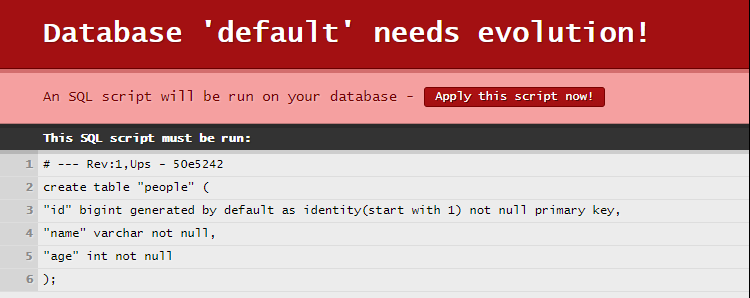Page History
| Info |
|---|
자바진영의 대표적인 ORM으로 JPA가 있습니다. 네이밍이 의미하듯 JAVA 오브젝트를 사용해야하며 스칼라 프로젝트에서 자바코드와 썩일수가 있습니다. 순수 스칼라 오브젝트만 사용하여 ORM을 이용하고자 할시 Slick이 추천됩니다. 웹에서 MVC패턴은 템플릿을 포함하여 타 웹플랫폼과 크게 다를바가 없습니다. |
Dependency
| Code Block | ||||||||
|---|---|---|---|---|---|---|---|---|
| ||||||||
libraryDependencies += "com.h2database" % "h2" % "1.4.197" libraryDependencies ++= Seq( "com.typesafe.play" %% "play-slick" % "3.0.0", "com.typesafe.play" %% "play-slick-evolutions" % "3.0.0" ) |
...
| Code Block | ||||||||
|---|---|---|---|---|---|---|---|---|
| ||||||||
// main.scala.html
@(title: String)(content: Html)
<!DOCTYPE html>
<html>
<head>
<title>@title</title>
<link rel="shortcut icon" type="image/png" href="@routes.Assets.at("images/favicon.png")"/>
</head>
<body>
@content
</body>
</html>
// person.scala.html
@(person: Form[CreatePersonForm])(implicit request: MessagesRequestHeader)
@import helper._
@request.flash.get("success").map { key =>
@request.messages(key)
}
@main("Welcome to Play") {
@form(routes.PersonController.addPerson()) {
@inputText(person("name"))
@inputText(person("age"))
@CSRF.formField
<div class="buttons">
<input type="submit" value="Add Person"/>
</div>
}
} |
Model
ORM 과 SQL쿼리방식의 개발 차이는 여기에있습니다. 쿼리 방식에서는 해당 모델을 SQL문으로 한번더 맵핑처리를하여야하며
쿼리를 사용해야합니다. ORM에서는 엔티티와 모델이 일치함으로 추가적인 쿼리개발이 필요가 없습니다.
| Code Block | ||||||||
|---|---|---|---|---|---|---|---|---|
| ||||||||
//person.scala
//
package models
import play.api.libs.json._
case class Person(id: Long, name: String, age: Int)
object Person {
implicit val personFormat = Json.format[Person]
}
// personRepository.scala
//
package models
import javax.inject.{ Inject, Singleton }
import play.api.db.slick.DatabaseConfigProvider
import slick.jdbc.JdbcProfile
import scala.concurrent.{ Future, ExecutionContext }
/**
* A repository for people.
*
* @param dbConfigProvider The Play db config provider. Play will inject this for you.
*/
@Singleton
class PersonRepository @Inject() (dbConfigProvider: DatabaseConfigProvider)(implicit ec: ExecutionContext) {
// We want the JdbcProfile for this provider
private val dbConfig = dbConfigProvider.get[JdbcProfile]
// These imports are important, the first one brings db into scope, which will let you do the actual db operations.
// The second one brings the Slick DSL into scope, which lets you define the table and other queries.
import dbConfig._
import profile.api._
/**
* Here we define the table. It will have a name of people
*/
private class PeopleTable(tag: Tag) extends Table[Person](tag, "people") {
/** The ID column, which is the primary key, and auto incremented */
def id = column[Long]("id", O.PrimaryKey, O.AutoInc)
/** The name column */
def name = column[String]("name")
/** The age column */
def age = column[Int]("age")
/**
* This is the tables default "projection".
*
* It defines how the columns are converted to and from the Person object.
*
* In this case, we are simply passing the id, name and page parameters to the Person case classes
* apply and unapply methods.
*/
def * = (id, name, age) <> ((Person.apply _).tupled, Person.unapply)
}
/**
* The starting point for all queries on the people table.
*/
private val people = TableQuery[PeopleTable]
/**
* Create a person with the given name and age.
*
* This is an asynchronous operation, it will return a future of the created person, which can be used to obtain the
* id for that person.
*/
def create(name: String, age: Int): Future[Person] = db.run {
// We create a projection of just the name and age columns, since we're not inserting a value for the id column
(people.map(p => (p.name, p.age))
// Now define it to return the id, because we want to know what id was generated for the person
returning people.map(_.id)
// And we define a transformation for the returned value, which combines our original parameters with the
// returned id
into ((nameAge, id) => Person(id, nameAge._1, nameAge._2))
// And finally, insert the person into the database
) += (name, age)
}
/**
* List all the people in the database.
*/
def list(): Future[Seq[Person]] = db.run {
people.result
}
} |
...
| Code Block | ||||||||
|---|---|---|---|---|---|---|---|---|
| ||||||||
package controllers
import javax.inject._
import models._
import play.api.data.Form
import play.api.data.Forms._
import play.api.data.validation.Constraints._
import play.api.i18n._
import play.api.libs.json.Json
import play.api.mvc._
import scala.concurrent.{ExecutionContext, Future}
class PersonController @Inject()(repo: PersonRepository,
cc: MessagesControllerComponents
)(implicit ec: ExecutionContext)
extends MessagesAbstractController(cc) {
/**
* The mapping for the person form.
*/
val personForm: Form[CreatePersonForm] = Form {
mapping(
"name" -> nonEmptyText,
"age" -> number.verifying(min(0), max(140))
)(CreatePersonForm.apply)(CreatePersonForm.unapply)
}
/**
* The index action.
*/
def index = Action { implicit request =>
Ok(views.html.person(personForm))
}
/**
* The add person action.
*
* This is asynchronous, since we're invoking the asynchronous methods on PersonRepository.
*/
def addPerson = Action.async { implicit request =>
// Bind the form first, then fold the result, passing a function to handle errors, and a function to handle succes.
personForm.bindFromRequest.fold(
// The error function. We return the index page with the error form, which will render the errors.
// We also wrap the result in a successful future, since this action is synchronous, but we're required to return
// a future because the person creation function returns a future.
errorForm => {
Future.successful(Ok(views.html.person(errorForm)))
},
// There were no errors in the from, so create the person.
person => {
repo.create(person.name, person.age).map { _ =>
// If successful, we simply redirect to the index page.
Redirect(routes.PersonController.index).flashing("success" -> "user.created")
}
}
)
}
/**
* A REST endpoint that gets all the people as JSON.
*/
def getPersons = Action.async { implicit request =>
repo.list().map { people =>
Ok(Json.toJson(people))
}
}
}
/**
* The create person form.
*
* Generally for forms, you should define separate objects to your models, since forms very often need to present data
* in a different way to your models. In this case, it doesn't make sense to have an id parameter in the form, since
* that is generated once it's created.
*/
case class CreatePersonForm(name: String, age: Int) |
...
evolution
최초 DB설정시 테이블생성 마이그레이션등에 활용될수 있는듯 하며 , 테이블을 어플리케이션이 생성하는
방법은 대부분 정책적인 이슈로 금지되며, 개발 초기단계에서 활용이 가능할것으로 보입니다.
| Code Block | ||||||
|---|---|---|---|---|---|---|
| ||||||
# --- !Ups create table "people" ( "id" bigint generated by default as identity(start with 1) not null primary key, "name" varchar not null, "age" int not null ); # --- !Downs drop table "people" if exists; |


